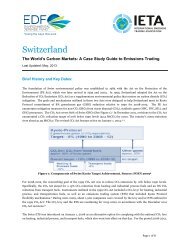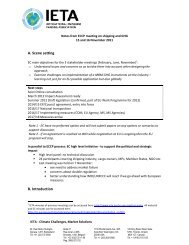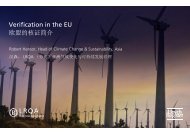Japan / The World's Carbon Markets - IETA
Japan / The World's Carbon Markets - IETA
Japan / The World's Carbon Markets - IETA
Create successful ePaper yourself
Turn your PDF publications into a flip-book with our unique Google optimized e-Paper software.
<strong>Japan</strong><br />
<strong>The</strong> World’s <strong>Carbon</strong> <strong>Markets</strong>: A Case Study Guide to Emissions Trading<br />
Last Updated: September, 2013<br />
Environmental Policy Overview:<br />
<strong>Japan</strong> is the third biggest economy in the world, 1 and, in 2010, its GHG emissions (including LULUCF) of 1,208<br />
million metric tons of carbon dioxide equivalent (MMtCO2e) 2 placed it fifth among the world’s countries. 3 In the July<br />
2008 “Action Plan for Achieving a Low-carbon Society,” <strong>Japan</strong> introduced possible GHG emission reduction goals. 4<br />
As part of the Copenhagen Accord, <strong>Japan</strong> pledged to reduce GHG emissions 25% below 1990 levels by<br />
2020. 5 <strong>The</strong> country’s 2030 goal is to reduce CO2 from fossil fuels 30% below 1990 levels. 6 In December 2010, the<br />
<strong>Japan</strong>ese Central Environmental Council confirmed that <strong>Japan</strong> would commit to reducing its GHG emissions to 80%<br />
below 1990 levels by 2050. 7 <strong>Japan</strong> also made a commitment under the Kyoto Protocol to reduce its average<br />
annual GHG emissions 6% below 1990 levels for 2008-2012. According to Reuters (2013), however, “<strong>Japan</strong><br />
emitted 313 million tons of CO2 equivalent more than its annual target during the Kyoto Protocol… <strong>The</strong> country will<br />
make up the shortfall through buying emission permits from other governments or project-based offset credits from<br />
major developing countries and Eastern Europe.” 8 At the 2010 conference of parties (COP) in Cancun <strong>Japan</strong> declined<br />
to renew its Kyoto commitment. 9<br />
<strong>The</strong> goals enumerated above are ambitious compared to those of other industrialized countries. However, <strong>Japan</strong>’s<br />
2020 target is contingent upon ample international action, as defined by the <strong>Japan</strong>ese government, and, according to<br />
a 2011 World Bank report, “in the absence of such an agreement, it appears unlikely that <strong>Japan</strong> will make a unilateral<br />
25 percent cut.” 10 On January 25 th 2013, Prime Minister Abe ordered the Minister of the Environment and other<br />
relevant ministers to reexamine climate change policies and “conduct a zero-based review of the 25% emission<br />
reduction target by COP19 in next November as well as to develop assertive diplomatic strategies to tackle climate<br />
change with the aim of contributing to the world by fully utilizing <strong>Japan</strong>ese advanced technologies.” 11 According to<br />
Reuters (2010) the <strong>Japan</strong>ese target would be virtually impossible to achieve unless the country were to commit to<br />
steeper emissions cuts from manufacturers, power generators, offices, and commercial operations which combined<br />
account for 60% of the country’s total GHG emissions. 12 According to Reuters (2012) 13 and PBL Netherlands<br />
Environmental Assessment Agency (2012) 14 , the earthquake and tsunami of March 2011 and the resulting Fukushima<br />
nuclear power plant disaster have forced <strong>Japan</strong> to review its current climate and energy policies. This policy review<br />
has raised questions about if and how the country will meet its 2020 target. 15 Prior to the Fukushima incident,<br />
METI’s June 2010 figures indicated that nuclear power’s percentage of <strong>Japan</strong>ese generation would increase from 26%<br />
in 2007 to 50% in 2030 16 ; so, potentially losing a significant quantity of low-carbon power generation could stress<br />
<strong>Japan</strong>’s achievement of its climate targets. Furthermore, according to PBL Netherlands Environmental Assessment<br />
Agency’s (2012) projections, if <strong>Japan</strong> were to fulfill its current climate commitments, the country’s GHG emissions<br />
would still exceed its 2020 pledge by 290 MtCO2e (see Figure 1). 17<br />
Page 1 of 9
Figure 1: <strong>Japan</strong>ese Emissions Reduction Pledge Relative to Business as Usual (BAU) and Active<br />
Climate Measures. Source: PBL; UNFCCC 2011 18<br />
In March 2010, the <strong>Japan</strong>ese government introduced the “Basic Act on Global Warming Countermeasures.” 19 An<br />
initial feature of the Act was a nation-wide emissions trading system (ETS) that would have begun in April 2013.<br />
While this nation-wide ETS was removed from the Act in December 2010, other cap-and-trade measures, such as the<br />
<strong>Japan</strong>ese Voluntary ETS (which began in 2005 and became part of the Experimental ETS in 2008), the Tokyo ETS,<br />
and the Experimental ETS (the trial period was for 2008-2012, and the government continues to encourage firms to<br />
participate), have been active in the country (see Table 1).<br />
Policy Jurisdiction Details<br />
Emissions<br />
Trading System<br />
<strong>Japan</strong><br />
On Mach 12, 2010, the government of <strong>Japan</strong> proposed the “Basic Act<br />
on Global Warming Countermeasures”, an overall climate change<br />
policy framework that includes introducing an ETS<br />
Feed-In Tariffs <strong>Japan</strong> Feed-in tariff for all renewable energy sources with the goal of<br />
increasing domestic energy generation from renewable sources by<br />
10% of total primary energy supply by 2020<br />
Anti-Global<br />
Warming<br />
Measure Tax<br />
Voluntary<br />
Experimental<br />
Integrated ETS<br />
Tokyo Emissions<br />
Trading System<br />
(cap and trade)<br />
Saitama<br />
Prefecture<br />
Trading System<br />
(Cap-and-Trade)<br />
<strong>Japan</strong><br />
Anti-global warming tax is proposed as an add-on to existing taxes<br />
covering a wide range of fuels, of which rates are proportional to CO2<br />
emissions<br />
715 organizations 715 organizations had applied to participate, of which 521 supplied<br />
targets (as of July 2009). <strong>The</strong> trial program aims to bring together<br />
several existing initiatives, such as the Keidanren Voluntary Action<br />
Plan, plans for a domestic offsets program, and the <strong>Japan</strong>-Voluntary<br />
Emissions Trading System (J-VETS), which targets smaller emitters<br />
Tokyo<br />
<strong>The</strong> Tokyo metropolitan area launched its own mandatory cap-andtrade<br />
system on April 1, 2010, which targets office and commercial<br />
buildings (including universities) and factories. <strong>The</strong> system covers<br />
approximately 1,400 installations and 1% of the country’s emissions<br />
Saitama Prefecture Starting April 1, 2011, Saitama, the fifth largest prefecture in <strong>Japan</strong>,<br />
became the second <strong>Japan</strong>ese prefecture to implement a mandatory<br />
emissions trading system. Saitama and Tokyo signed a pact to link<br />
their cap-and-trade programs in the future<br />
Table 1: Current Climate Change Policies in <strong>Japan</strong>. Source: Peak Oil (2011) 20<br />
Page 2 of 9
Domestic <strong>Markets</strong>:<br />
According to <strong>Japan</strong>’s former National Strategy Minister, Koichiro Gemba, the primary reason that the <strong>Japan</strong>ese ETS<br />
was deferred was because fellow nations (particularly the United States and Australia) struggled to develop their own<br />
robust climate policies. 21 <strong>The</strong> lack of international action presumably made it more difficult to overcome industry<br />
concerns over the economic consequences of the program. A September 2010 Nippon Keidanren-led survey<br />
questioned <strong>Japan</strong>’s most influential businesses and found that 61 out of 64 companies opposed the ETS. 22 In<br />
November 2012, <strong>Japan</strong>ese ETS as proposed in the Basic Act was formally abandoned when Prime Minister Noda<br />
dissolved the Lower House. 23<br />
DETAILS OF THE EMISSIONS TRADING PROGRAM PROPOSED BY THE JAPANESE MINISTRY OF<br />
ENVIRONMENT IN 2010: 24<br />
• Two phases: Phase I (2013-2015) and Phase II (2016-2020).<br />
• Covered gases: Initially only CO2, but there were considerations for including other gases. CO2 is responsible for<br />
95% of <strong>Japan</strong>ese GHG emissions.<br />
• Covered sectors: Primarily industry, business, and energy conversion.<br />
• Allowance Distribution: Each sector would have received an absolute emissions cap based on sector-specific<br />
emissions reduction potential.<br />
• Point of obligation: Downstream, firm-level.<br />
• Inclusion: Covered entities must hold an allowance for every unit of CO2 generated that exceeded emissions<br />
thresholds.<br />
• Banking: Allowed, but few details were determined.<br />
• Borrowing: To be determined.<br />
• Offsets: Emissions reductions and carbon sinks from domestic entities not covered by the program as well as<br />
valid international offsets offered via the Kyoto mechanism would have been included.<br />
• International linkage intentions: To be determined.<br />
• Price Volatility Measures: Cost-containment reserve.<br />
• Compliance: One-year commitment periods and penalties for non-compliance.<br />
• Monitoring, Reporting and Verification (MRV): Uniform emissions rules for reporting with third-party<br />
verification based on international standards.<br />
While this proposed nation-wide ETS was characterized by opponents as an ‘economic burden,’ an expert panel from<br />
the Environmental Ministry projects that such a program, which could have cut GHGs by up to 18% relative to<br />
BAU by 2020, would have had little adverse effect on <strong>Japan</strong>ese GDP or job growth. If <strong>Japan</strong>ese firms were to cut<br />
emissions 10% below 2006-2008 averages, the nation’s GHGs would be reduced by 84 MtCO2, an 18% reduction<br />
relative to the scenario that does not include the program, and the natural fall in employment of the productive<br />
population through 2020 would be less than 0.3%. 25<br />
JAPANESE VOLUNTARY EMISSIONS TRADING SYSTEM (JVETS): In September 2005, the Ministry of<br />
Environment <strong>Japan</strong> (MOEJ) constructed the <strong>Japan</strong>ese Voluntary Emissions Trading System (JVETS) to<br />
provide government support for <strong>Japan</strong>ese companies to reduce emissions through activities not supported by the<br />
Voluntary Action Plan (VAP). 26 <strong>The</strong> Competent Authority Committee (CAC), under MOEJ, managed JVETS; CAC<br />
drafted guidelines, approved monitoring plans and verification reports, and evaluated verifiers’ achievements. 27<br />
JVETS participants became part of the Experimental Integrated ETS in 2008. 28<br />
Page 3 of 9
From fiscal 2006-fiscal 2009, 303 companies participated in JVETS, and over this period the cumulative<br />
emissions reductions achieved was 1.990 MMtCO2e, an amount that exceeded the covered firms’ emissions reduction<br />
commitment of 0.961 MMtCO2e (see Table 2). 29 Of the participating firms, about 80 adopted absolute targets. <strong>The</strong><br />
target sectors for JVETS include non-VAP participants from nonferrous metal industry, ceramic, steel, machine<br />
and other manufacturing, chemical, pulp and paper, food and drink, textile, and some non-industrial sectors. 30 With<br />
less than 1% of the country’s industrial sector’s CO2 emissions represented by participating firms, policy<br />
makers learned that a mandatory system is necessary for substantive nation-wide emissions reductions. 31<br />
Nevertheless, JVETS helped to inform the construction of the proposed nation-wide <strong>Japan</strong>ese ETS. 32<br />
Commitment Period FY 2006 FY 2007 FY 2008 FY2009<br />
Achieved Reduction (kt-CO2) 377 (29%) 280 (25%) 383 (23%) 950 (28%)<br />
Committed Reduction (kt-CO2) 273 (21%) 217 (19%) 136 (8%) 335 (10%)<br />
Number or Transactions 24 51 23 24<br />
Average JPA Price (JPY/t-CO2) 33<br />
JPY$1,212<br />
(US$10.15)<br />
JPY$1,250<br />
(US$11.30)<br />
JPY$800<br />
(US$8.81)<br />
JPY$750<br />
(US$8.14)<br />
Table 2: JVETS results for fiscal 2006-fiscal 2009. Source: MoE <strong>Japan</strong> (2011) 34<br />
Under JVETS, participants with absolute emissions targets were obligated to submit a corresponding quantity of<br />
<strong>Japan</strong>ese Emission Allowances (JPAs) for every ton of emissions produced. Participants that emitted beneath their<br />
caps were allowed to sell to other participants who emitted in excess of their caps. <strong>The</strong>re was unlimited usage of<br />
Clean Development Mechanism (CDM) credits, known as j-CERs, as long as these credits were not the<br />
primary means for achieving pledged targets. Banking of allowances and credits was allowed, but borrowing was<br />
not. 35<br />
In an effort to incentivize participation, the <strong>Japan</strong>ese government subsidized one-third of the cost of GHG reduction<br />
measures until April 2009. In the event of non-compliance, entities were forced to return this subsidy to the<br />
government. 36<br />
EXPERIMENTAL INTEGRATED ETS (EI ETS): In October 2008, the Government of <strong>Japan</strong> initiated the<br />
Experimental Introduction of an Integrated Domestic Market for Emissions Trading (EI ETS) with the<br />
goal of assisting <strong>Japan</strong>’s efforts to reach its Kyoto target. Policy makers were able to use the EI ETS as a building<br />
block for the proposed nation-wide <strong>Japan</strong>ese ETS that was dropped [or abandoned] in November 2012. As<br />
mentioned above, the EI ETS incorporates JVETS. 37 <strong>The</strong> trial period for the EI ETS ended in 2012 but the<br />
government continues to encourage firms to participate. 38<br />
System participants set their own absolute or intensity-based emissions targets. <strong>The</strong>se targets are met<br />
with allowances and specified credits and are consistent with Voluntary Action Plans (VAPs). <strong>The</strong> government<br />
examines the validity of targets, and MRV for emissions is required. 39<br />
Individual firms are the primary players in the EI ETS. As of February 2009, 528 firms and organizations were<br />
participating in this system. 455 had set an emissions quota, 60 had made credit transactions, and 13 had engaged in<br />
some other form of participation. <strong>The</strong> 455 quota-setting firms come from the steel, automobile manufacture, cement,<br />
electricity, and oil refining sectors and make up approximately 70% of the industrial sector. <strong>The</strong> 60 companies<br />
that engaged in credit trades include banks, trading companies, and similar types of entities. 40<br />
J-CREDIT SYSTEM: In August 2013, the <strong>Japan</strong>ese government announced the launch of its J-Credit system for<br />
domestic offset projects. <strong>The</strong> system consolidates the existing <strong>Japan</strong> Offset Credit (J-VER) scheme, a voluntary offset<br />
mechanism creating credits for mainly Corporate Social Responsibility (CSR) reasons 41 , and the Domestic CDM<br />
Page 4 of 9
voluntary offset program. 42 <strong>The</strong> system provides voluntary credits that companies can use as part of the Keidanren’s<br />
“commitment to a low carbon society” program. <strong>The</strong> business community established this voluntary program in 2009<br />
to reduce emissions in industry and energy saving measures through company level target reductions to 2020. 43 <strong>The</strong><br />
system also allows credits to be used for compliance with targets set under either the Act on Promotion of Global<br />
ProcessoftheJCreditScheme<br />
Warming Countermeasures or the Energy Efficiency Act, or as part of voluntary carbon offsetting. 44<br />
Step<br />
ProjectParticipant<br />
AccreditedValidator/Verifier<br />
SchemeOwnerCommittee<br />
(Secretariat)<br />
DevelopmentofPDD<br />
Development<br />
ofMethodology<br />
( Ifnecessary)<br />
Submissionof<br />
Proposed<br />
Methodology<br />
Approvalof<br />
Proposed<br />
Methodology<br />
ProjectPlanning<br />
Development<br />
ofPDD<br />
Contract<br />
RegistrationofProject<br />
Validation<br />
Accept<br />
ValidationReport<br />
Report<br />
Validation<br />
Consideration<br />
Registration<br />
MonitoringCertification<br />
RequestRegistrationof<br />
Project<br />
Consideration<br />
Registration<br />
Monitoring<br />
Calculation<br />
MonitoringCalculation<br />
Report<br />
Contract<br />
Verification<br />
Accept<br />
VerificationReport<br />
Verification<br />
Consideration<br />
Certification<br />
RequestCertificationof<br />
Credit<br />
Consideration<br />
Certification<br />
Figure 2: J-Credit System Process (Source: Ministry of Economy, Trade and Industry (METI)<br />
September 2013<br />
14<br />
Participation in the Domestic CDM program prohibited participants of the Voluntary Action Plan to host projects.<br />
<strong>The</strong> J-Credit system does not include this restriction, allowing companies with a Voluntary Action Plan to also<br />
participate in J-Credit projects. To avoid double counting, however, if the project is part of the Keidanren’s<br />
Commitment to a Low <strong>Carbon</strong> Society then its credits can not be used to fulfill the company level targets ascribed<br />
under this program. <strong>The</strong>re is also a range of methodologies available to project participants. As of July 2013, 56<br />
methodologies have been approved, including 37 energy saving, 9 renewable energy, 4 industrial processes, 3<br />
agriculture, 2 forestry and 1 waste sector methodology. 45<br />
Projects that can be considered in the J-Credit Scheme must meet the following conditions:<br />
1. Be implemented within <strong>Japan</strong><br />
2. Be implemented after April 1, 2013<br />
3. Satisfy additionality requirements<br />
4. Be implemented based on methodologies<br />
5. Be validated by validation authorities<br />
6. Take action to ensure permanence (forest sink projects only) 46<br />
<strong>The</strong> J-Credit system is scheduled to terminate on March 31, 2021. Credits from the Domestic CDM and J-VER<br />
programs will expire on the same date. <strong>The</strong> expiration date for J-Credits will be discussed in the future. 47<br />
Page 5 of 9
International <strong>Markets</strong>:<br />
International offsets have been crucial for <strong>Japan</strong> to meet its pre-2020 climate goals, such as its 6% Kyoto target. 48<br />
At present, however, the role offsets will play in achieving <strong>Japan</strong>ese climate goals beyond the near future is unclear,<br />
for the country’s climate policies are being re-examined. <strong>Japan</strong> has signed agreements with several nations in<br />
Southeast Asia to launch the Joint Crediting Mechanism (JCM). Under this scheme, <strong>Japan</strong> provides low-carbon<br />
technologies, products, and services to designated partner countries, which these partner countries then use to create<br />
GHG emissions reductions. For example, <strong>Japan</strong>ese companies can implement greenhouse gas emission reduction<br />
projects in the developing countries, such as installing renewable energy capacity or planting trees, which can earn<br />
the companies credits for their own emissions reduction targets. 49 JCM frameworks are being constructed and agreed<br />
upon on a country-by-country basis. As of September 2013, <strong>Japan</strong> has signed agreements with Bangladesh, Vietnam,<br />
Mongolia, Ethiopia, Kenya, Laos, and Indonesia. 50 <strong>Japan</strong>’s Environment Ministry continues to increase, and<br />
potentially to more than double, its spending on promoting JCM and subsidizing emission reduction projects and<br />
feasibility studies for emission reduction projects in developing nations. 51<br />
<strong>The</strong> JCM features a Joint Committee (JC) comprised of representatives of the <strong>Japan</strong>ese and host governments. <strong>The</strong><br />
committee is responsible for resolving technical issues, such as the approval of methodologies and projects, and the<br />
issuance of JCM credits. Methodologies are developed and proposed by project developers and the JC must give its<br />
approval. Following an agreement between <strong>Japan</strong> and Mongolia, the JC has developed numerous guidelines<br />
necessary for implementing the JCM. 52<br />
As mentioned earlier, since 2008 JVETS has allowed firms to meet their targets through unlimited CDM usage. 53<br />
Regulation and Oversight:<br />
A byproduct of JVETS is competent <strong>Japan</strong>ese monitoring, reporting, and third-party verification<br />
capacity. In addition, a registry for emissions trading and an emissions management system were also developed. 54<br />
<strong>The</strong> registry prevents double-counting of allowances, provides for secure allowance retirement, and provides a<br />
public, web-based registry for all participants. <strong>The</strong> Trade Matching System is another web-based tool that<br />
enables participants to find trading partners. <strong>The</strong> following features characterize the emissions management<br />
system: integrated calculation methodology; centralized database of all stakeholder information; and standardized<br />
and efficient emissions calculation and verification processes. 55 <strong>The</strong> J-Credit System, scheduled to commence in the<br />
second half of 2013, merges the Domestic CDM and J-VER registry systems. 56<br />
Within the JCM, registries will be constructed within the host government, and managed in <strong>Japan</strong>. <strong>The</strong> intention is<br />
for credits to be transferred from private entities to the <strong>Japan</strong>ese government. <strong>The</strong> current policy is to have a “nontradable”<br />
system where transfers take place between companies and the government. 57<br />
Recent Environmental History:<br />
In November 2008, MOEJ introduced <strong>Japan</strong>ese Verified Emissions Reductions (J-VER), which is an offset<br />
crediting system that is comprised of verified emission reductions and removal projects from small/medium-sized<br />
enterprises (SMEs), agriculture, and forestry. This system credits domestic projects that function as additional GHG<br />
sinks. J-VER has also helped to promote the Green New Deal program via expansion of job opportunities, global<br />
warming prevention, and economic measures funded by the private sector. 58 As of September 2011, 160 projects were<br />
registered with the J-VER program and, of them, 98 had received J-VER certification. A total of 139,317 tCO2 had<br />
been credited via J-VER. 59<br />
Page 6 of 9
While the nation-wide, mandatory ETS was abandoned in November 2012; the Basic Act on Global Warming<br />
Countermeasures introduced a carbon tax and established a feed-in tariff for all renewable energy<br />
sources. <strong>The</strong>se measures introduce new taxes on coal, oil, and natural gas, as well as a feed-in tariff that incentivizes<br />
increased domestic renewable energy generation in order to meet the 2020 clean primary energy supply target of<br />
10%. 60 For FY 2011, the tax on fossil fuels increased by JPY$ 0.76 (USD$0.0096 61 ) per liter of petrol, an amount<br />
corresponding to an annual outlay of more than JPY$ 1,000 (USD$12.61 62 ) per household. 63<br />
National Level<br />
1990s<br />
1990: Action Plan to Arrest Global Warming<br />
1998: Adoption of Kyoto Protocol in <strong>Japan</strong><br />
- Promotion of Nuclear Power<br />
- Energy Conservation Law<br />
- Law Concerning the Promotion of Measures to Cope with Global Warming<br />
2000-2005 2002: Ratification of Kyoto Protocol<br />
- Decentralized climate change planning under “Target Achievement Plan”<br />
2005: Enforcement of Kyoto Protocol<br />
- Lower levels of government plans drawn up<br />
2005-<br />
present<br />
2008: Complete revision of Target Achievement Plan<br />
- Focus shifts more towards Kyoto mechanism.<br />
2009: Prime Minister Yukio Hatoyama announces cuts of 25% from 1990 levels<br />
2012: Prime Minister Noda dissolved the Lower House and abandoned the proposed<br />
nation-wide ETS<br />
2013: Prime Minister Abe ordered the reexamination of <strong>Japan</strong>’s climate policies,<br />
including the 25% reduction target by 2020 relative to 1990 levels.<br />
Table 2: History of Action on Climate Change Mitigation in <strong>Japan</strong>. Source: PBL 2012 64<br />
CHALLENGES:<br />
1. As evidenced by the deferral of a nation-wide ETS in December 2010 and the subsequent abandonment in<br />
November 2012, concerns over ETS costs in <strong>Japan</strong> are influential.<br />
2. <strong>Japan</strong>’s climate targets are ambitious compared to those of other industrialized countries, but <strong>Japan</strong>’s refusal<br />
to renew its Kyoto commitment may indicate that political interest in climate action is waning.<br />
UNIQUE ISSUES:<br />
1. <strong>The</strong>re is splintered sentiment toward cap-and-trade in <strong>Japan</strong>. At the local level, the Tokyo government,<br />
the country’s largest sub-national governing body, implemented an ETS with absolute, mandatory targets in<br />
April 2010. At the national level, JVERS and the EI ETS have built regulatory and infrastructural capacity for<br />
emissions trading. Despite these promising ETS actions, momentum towards a mandatory, nation-wide ETS<br />
with absolute caps has stagnated since December 2010.<br />
Page 7 of 9
2. Public backlash against nuclear power in the wake of the Fukushima power plant disaster will require <strong>Japan</strong> to<br />
restructure its plans in order to meet its 2020 climate targets. As a result, the country may be forced to<br />
significantly increase its use of international offsets.<br />
Author Acknowledgements:<br />
If you have any comments or suggestions for this case study, please do not hesitate to contact lead authors:<br />
EDF co-author: Peter Sopher<br />
Point of contact: Daniel Francis (dfrancis@edf.org)<br />
Environmental Defense Fund (EDF)<br />
1875 Connecticut Ave NW Ste. 600<br />
Washington, DC<br />
<strong>IETA</strong> co-author: Anthony Mansell<br />
Point of contact: Anthony Mansell (Mansell@ieta.org)<br />
International Emissions Trading Association (<strong>IETA</strong>)<br />
20 F St NW Suite 700<br />
Washington, DC<br />
<strong>The</strong> authors would like to thank Ruben Lubowski, Joe Billick, Clayton Munnings, Jennifer Andreassen, Richie Ahuja,<br />
Cassandra Mitchell, Takahiro Ueno (CRIEPI, <strong>Japan</strong>), and Miki Yanagi (IEEJ) for very helpful comments and<br />
information for this case study. We take full responsibility for any remaining errors.<br />
Disclaimer: <strong>The</strong> authors encourage readers to please contact them with any corrections, additions, revisions, or any<br />
other comments, including any relevant citations. This will be invaluable in strengthening and updating the case<br />
studies and ensuring they are as correct and informative as possible.<br />
1 Rudolph, Sven and Takeshi Kawakatsu. 2012. “Tokyo’s Greenhouse Gas Emissions Trading Scheme: A Model for Sustainable Megacity <strong>Carbon</strong> <strong>Markets</strong>?”<br />
MAGKS. Joint Discussion Paper Series in Economics. http://www.uni-marburg.de/fb02/makro/forschung/magkspapers/25-2012_rudolph.pdf<br />
2 United National Framework Convention on Climate Change (UNFCCC) (December 2012). “Annual compilation and accounting report for Annex B Parties under<br />
the Kyoto Protocol for 2012.” Available at http://unfccc.int/resource/docs/2012/cmp8/eng/09a01.pdf<br />
3 United Nations Statistics Division. “<strong>Carbon</strong> dioxide emissions (CO2), thousand metric tons of CO2 (CDIAC).” Millenium Development Goals Indicators. Available<br />
at http://mdgs.un.org/unsd/mdg/SeriesDetail.aspx?srid=749&crid=<br />
4 “Action Plan for Achieving a Low-<strong>Carbon</strong> Society.” (July 2008). Available at http://www.kantei.go.jp/foreign/policy/ondanka/final080729.pdf<br />
5 Monjon, Stephanie (October 2011). “Implementation of an emission trading scheme in <strong>Japan</strong>: Some food for thought.” Climate Strategies. Available at<br />
http://www.climatestrategies.org/research/our-reports/category/32/340.html<br />
6 Maeda, Risa (December 2010). “<strong>Japan</strong> shelves carbon emissions trading scheme.” Reuters. Available at http://www.reuters.com/article/2010/12/28/us-climatejapan-idUSTRE6BR06120101228?feedType=RSS&feedName=environmentNews<br />
7 Domestic Emissions Trading Subcommittee of the Global Environmental Committee with in the <strong>Japan</strong>ese Central Environmental Council (December 2010). “Key<br />
Features of Domestic Emissions Trading Scheme in <strong>Japan</strong> (Interim Report).” Available at http://www.env.go.jp/en/earth/ets/mkt_mech/key-features1012_tt.pdf<br />
8 Maeda, Risa and Stien Reklev (April 2013). “<strong>Japan</strong> confirms 2.9 pct rise in carbon emissions 2011/12.” Reuters Point <strong>Carbon</strong>. Available at<br />
http://www.pointcarbon.com/news/1.2272290?&ref=searchlist<br />
9 Peak Oil (January 2011). “<strong>Japan</strong> Rejects Cap and Trade.” Available at http://peakoil.com/publicpolicy/japan-rejects-cap-and-trade/<br />
10 World Bank (June 2011). “State and Trends of the <strong>Carbon</strong> Market 2011.” Washington DC. Available at<br />
http://siteresources.worldbank.org/INTCARBONFINANCE/Resources/StateAndTrend_LowRes.pdf<br />
11 Cabinet Secretariat, Cabinet Public Relations Office (January 2013). “On policy deployment for the time being based on the discussion at the first meeting of the<br />
Industrial Competitiveness Council.” Available at http://www.kantei.go.jp/foreign/96_abe/decisions/2013/0125competitiveness_e.html<br />
12 Supra, Note 6.<br />
13 Garside, Ben (May 2012). “<strong>Japan</strong>’s climate goal in balance as it mulls nuclear exit.” Thomas Reuters Point <strong>Carbon</strong>. Available at<br />
http://www.pointcarbon.com/news/1.1905622<br />
14 den Elzen, Michel, Mark Roelfsema, Andries Hof, Hannes Bottcher, and Giacoo Grassi (2012). “Analysing the emission gap between pledged emission reductions<br />
under the Cancun Agreements and the 2°C climate target.” PBL Netherlands Environmental Assessment Agency (PBL). Available at<br />
http://www.sustainableguernsey.info/blog/wp-content/uploads/2012/05/2012-M04-290412-pbl-2012-analysing-the-emission-gap-between-pledged-emissionreductions-500114021.pdf<br />
15 Supra, Note 14.<br />
16 Ministry of Economy, Trade and Industry (METI), <strong>Japan</strong> (June, 2010). “<strong>The</strong> Strategic Energy Plan of <strong>Japan</strong>.” Available at<br />
http://www.meti.go.jp/english/press/data/pdf/20100618_08a.pdf<br />
17 Supra, Note 14.<br />
18 Supra, Note 14.<br />
19 Supra, Note 10.<br />
20 Supra, Note 10.<br />
21 Supra, Note 5.<br />
22 Sharp, Andy (December 2010). “<strong>Japan</strong> Drops Cap and Trade.” <strong>The</strong> Diplomat. Available at http://the-diplomat.com/tokyo-notes/2010/12/30/japan-dropscap-and-trade/<br />
23 Tanaka, Izumi (November 2012). “<strong>Japan</strong>’s position infor COP18 – nationella, regional och internationella fragor.” Swedish Agency for Growth Policy Analysis.<br />
Available at http://www.tillvaxtanalys.se/download/18.69e9bee013b03a9470a1662/1354095658793/COP18_<strong>Japan</strong>_2012_Climate+Negotiations.pdf<br />
24 <strong>Japan</strong>ese Ministry of Environment (September 2010). “Scheme Options: For <strong>Japan</strong>ese Emissions Trading Scheme Based on Cap and Trade System.” Available at<br />
http://www.env.go.jp/en/earth/ets/mkt_mech/scheme-options100910.pdf<br />
Page 8 of 9
25 <strong>The</strong> <strong>Japan</strong> Times (March 2010). “Cap and trade won’t hurt: eco panel.” Available at http://www.japantimes.co.jp/text/nb20120314a2.html<br />
26 <strong>The</strong> goal of the Voluntary Action Plan (VAP) was for participants to stabilize CO2 emissions from industrial processes and fuel combustion at the 1990 level by<br />
2010. <strong>The</strong> VAP began in 1997, and 35 industries participated including energy, mining, manufacturing, and construction. While the <strong>Japan</strong>ese government<br />
included the VAP in its Kyoto Protocol Target Management Achievement Plan, the voluntary nature of the VAP means that VAP participants made no commitment<br />
to the government about achieving stated targets. Source: Kiko Network. “Fact sheet of the Keidanren Voluntary Action Plan.” Available at<br />
http://www.kikonet.org/english/publication/archive/keidanren-vap.pdf<br />
27 Industrial Efficiency Policy Database (2012). “JP-2: <strong>Japan</strong>ese Voluntary Emissions Trading Scheme (JVETS).” Institute for Industrial Productivity. Available at<br />
http://iepd.iipnetwork.org/policy/japanese-voluntary-emissions-trading-scheme-jvets<br />
28 Toda, Eisaku. “Recent Development in Cap and Trade in <strong>Japan</strong>.” Ministry of Environment, <strong>Japan</strong>. Available at<br />
http://www.icapcarbonaction.com/phocadownload/tokyo_conf/icap_tokyo_conf_plenarytwo_toda_english.pdf<br />
29 Ministry of the Environment, <strong>Japan</strong> (May 2011). “<strong>Japan</strong>’s Voluntary Emissions Trading Scheme (JVETS).” Available at<br />
http://www.env.go.jp/en/earth/ets/jvets1105.pdf<br />
30 Supra, Note 27.<br />
31 Supra, Note 5.<br />
32 Supra, Note 27.<br />
33 <strong>The</strong> exchange rate used by this report comes from January 1 st of within the fiscal year indicated. For example, for FY2006, the exchange rate used is from<br />
January 1 st 2007. Source: OANDA Corporation (1996-2013). “Historical Exchange Rates.” Available at http://www.oanda.com/currency/historical-rates/<br />
34 Ministry of Environment, <strong>Japan</strong> (May 2011). “<strong>Japan</strong>’s Voluntary Emissions Trading Scheme (JVETS)”. Available at<br />
http://www.env.go.jp/en/earth/ets/jvets1105.pdf<br />
35 Supra, Note 27.<br />
36 Supra, Note 27.<br />
37 Supra, Note 28.<br />
38 <strong>The</strong> <strong>Japan</strong> Journal. “Cap-and-Trade: Does it Fit <strong>Japan</strong>?” Available at http://www.gov-online.go.jp/pdf/hlj_ar/vol_0021e/16-17.pdf<br />
39 Supra, Note 26.<br />
40 Supra, Note 38.<br />
41 For more information on the J-VER scheme, http://www.j-ver.go.jp/e/about_jver.html<br />
42 http://japancredit.go.jp/pdf/english/credit_english_001.pdf<br />
43 http://www.keidanren.or.jp/english/policy/2009/107.html<br />
44 Supra Note 42<br />
45 Supra Note 42<br />
46 Supra Note 42<br />
47 Supra Note 42<br />
48 Supra, Note 10.<br />
49 http://www.pointcarbon.com/news/1.2415832?date=20130613&sdtc=1<br />
50 http://www.mmechanisms.org/e/initiatives/index.html<br />
51 http://www.pointcarbon.com/news/1.2547834?date=20130902&sdtc=1<br />
52 Takashi Hongo (2013) <strong>Japan</strong>’s Joint Crediting Mechanism: A bottom-up CDM? <strong>IETA</strong> Greenhouse Gas Market 2013 (forthcoming).<br />
53 Yamada, Kazuhito (May 2011). “<strong>Japan</strong>’s Voluntary Emissions Trading Scheme (JVETS).” JICA and TGO. Available at<br />
http://www.conference.tgo.or.th/download/tgo_main/jica/ppt/100511/CT06_CT07_CT08.pdf (May 2011)<br />
54 Supra, Note 53<br />
55 Supra, Note 53.<br />
56 Supra Note 42<br />
57 Supra Note 51<br />
58 Supra, Note 28.<br />
59 <strong>Japan</strong> Ministry of Environment (MOEJ) Office of Market Mechanisms and Overseas Environmental Cooperation Center, <strong>Japan</strong> (OECC) (November 2011). “New<br />
Mechanisms Express – Promoting New Market Mechanisms for Climate Change Mitigation.” Available at http://www.mmechanisms.org/document/new_Mecha-<br />
Express/NewMechaExp_Nov2011_E_p.pdf<br />
60 Supra, Note 10.<br />
61 Supra, Note 33.<br />
62 Supra, Note 33.<br />
63 Supra, Note 22.<br />
64 World Bank (June 2010). “Tokyo’s Emissions Trading System: A Case Study.” Urban Development Unit. Available at<br />
http://siteresources.worldbank.org/INTURBANDEVELOPMENT/Resources/336387-1226422021646/Directions5.pdf?resourceurlname=Directions5.pdf<br />
Page 9 of 9










![South Korea [PDF] - International Emissions Trading Association](https://img.yumpu.com/38055599/1/190x245/south-korea-pdf-international-emissions-trading-association.jpg?quality=85)
